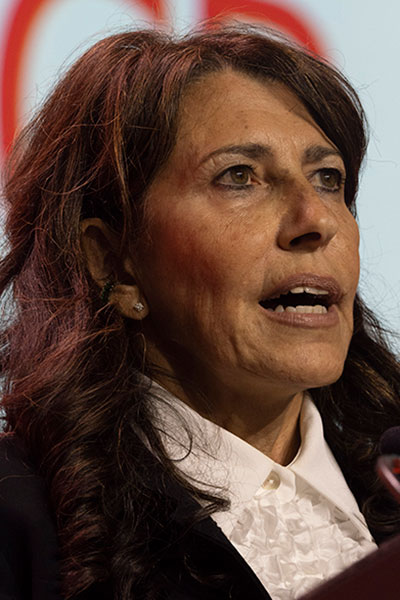SABCS has long recognized that open discussion of controversial topics is an integral part of improving clinical practice. The Clinical Controversies session at SABCS on Wednesday, December 7, explored evolving questions around the utility of targeted axillary dissection, the optimal duration of endocrine therapy and the role of neoadjuvant therapy in triple negative breast cancer (TNBC).

To clip or not to clip
The practice of tattooing or implanting a metal clip to mark positive axillary nodes identified by biopsy has come under increasing question in recent years. A growing body of evidence suggests that clipping positive nodes for later targeted axillary dissection (TAD) no longer has prognostic significance in the clinic. Neoadjuvant chemotherapy not only downstages the primary tumor but can clear axillary nodal metastases for many patients.
“We have 10-year follow-up data showing that standard sentinel node biopsy without clipping does not translate into worse outcomes for patients,” said Viviana Galimberti, MD, Director of Senology, European Institute of Oncology, Milan, Italy. “Clipping axillary nodes is more expensive, more time consuming, and more difficult than not clipping. “We don’t know how many nodes should be clipped, we don’t know what to do when a clip is lost, and we have no data showing that clipping improves outcomes.”

That may be true in the trial setting but in the real world, evaluating clipped nodes plus sentinel nodes gives a more accurate assessment of response to treatment, said Abigail Caudle, MD, Professor of Breast Surgery Oncology, The University of Texas MD Anderson Cancer Center.
“A clipped node is a node with known disease,” she said. “If you only look at sentinel nodes, you miss the node where you know there was cancer present.”
Not surprisingly, 82% of American Society of Breast Surgeons place clips in biopsied axillary nodes. Experience at MD Anderson and other centers shows evaluation of clipped nodes vs. sentinel lymph node alone or the clipped node alone significantly improves accuracy. Confirmation of residual disease affects adjuvant treatment decisions in HER2+, TNBC, HR+ and BRCA patients.
“Residual small volume disease in the axilla has important prognostic and therapeutic implications we cannot ignore,” Dr. Caudle said.

Duration of endocrine therapy
The appropriate duration of anti-estrogen is a familiar question. One year of ET is better than none, two is better than one, and five is better than two, said Kathryn Ruddy, MD, PhD, Professor of Oncology at Mayo Clinic.
“But there’s a diminishing return on each of these,” she continued. “Some patients probably benefit more from longer treatments while others don’t get much benefit. A little discomfort or morbidity goes a long way when you’re treating for years at a stretch.”
Two large trials, ATLAS and aTTom, support >5 years of tamoxifen in a combined cohort of nearly 20,000 patients, Dr. Ruddy noted. Longer treatment has clear benefits in reduced recurrence and reduced mortality, but there are corresponding increases in the risk of hospitalization or death from pulmonary embolus as well as endometrial cancer.

There is benefit from extended endocrine therapy, but that benefit is modest at best,” added Eleftherios “Terry” Mamounas, MD, MPH, Director of the Comprehensive Breast Program, Orlando Health Cancer Institute. “We have tools that can help us to better refine the risk of late recurrence after 5 years of breast cancer.”
CTS5, Clinical Treatment Score Post-5 Years, can help predict late distant recurrence. The online calculator is available at cts5-calculator.com. Multiple gene expression profiles can accurately predict the risk of late recurrence in some cancer subtypes. The Breast Cancer Index (BCI) and MammaPrint assay can predict benefit from extended ET. Circulating tumor cells and ctDNA may also be of value in the future.
“We have opportunities to alter the natural history of disease,” Dr. Mamounas said.
Post neoadjuvant therapy in TNBC

Most TNBC patients now receive neoadjuvant chemotherapy combined with immunotherapy followed by adjuvant immunotherapy. But benefits of this therapeutic regimen are not uniform among patients.
Those who achieve a pathologic complete response (pCR) have at least a 92% event-free survival at three years regardless of whether they had chemotherapy alone or chemo + immunotherapy, said Heather McArthur, MD, MPH, Associate Professor of Hematology/Oncology at the University of Texas Southwestern.
“While those with residual disease benefited from receiving immunotherapy, about one in three relapsed within those three years,” she said. “We clearly have more work to do.”
One question is the appropriate course of immunotherapy. In theory, a longer course should benefit patients, Dr. McArthur said, but clinical practice remains variable. Trials now underway may help resolve the sometimes-contentious debate.

“We don’t have biomarkers we can apply upfront to identify patients who are going to achieve pCR,” Dr. McArthur said. “We need upfront predictors.”
Genetic testing is one possibility. The OlympiA Trial compared adjuvant olaparib vs. placebo in patients who have BRCA1 or BRCA2 mutations. Olaparib showed significant improvement in invasive DFS, overall survival, and distant DFS at 3 years. Updated results reported in 2022 showed similar benefits out to 54 months with similar quality of life.
“To see an overall survival benefit at three years is very significant for our patients,” said Susan Domchek, MD, Professor of Oncology at the University of Pennsylvania. “More trials of more combinations are planned.”

